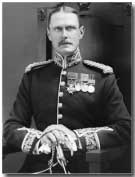Who's Who - Sir Alexander Godley
 Sir Alexander John Godley
(1867-1957) was responsible for the pre-war training of New Zealand forces
and subsequently led many of them during the First World War.
Sir Alexander John Godley
(1867-1957) was responsible for the pre-war training of New Zealand forces
and subsequently led many of them during the First World War.
Godley was born in Kent, England on 4 February 1867 the son of a British Army captain. Of an Irish background (which he made much of in later years) Godley was nevertheless entirely educated in England.
He entered Sandhurst in 1885, receiving a commission as a Lieutenant to the Royal Dublin Fusiliers the following year. Promoted to Captain in 1896 and made Adjutant of the mounted infantry at Aldershot, Godley next volunteered to serve with a mounted infantry battalion in suppressing a rebellion in Mashonaland.
Upon his return to England in 1897 Godley received a promotion to Brevet Major; the following year he gained acceptance into the staff college at Camberley. He quickly determined however to travel to South Africa to serve in the brewing Anglo-Boer conflict, leaving Camberley early to do so.
1900 brought Godley an appointment as Chief Staff Officer to Herbert Plumer (of subsequent Messines fame). Following the South African War Godley served for a short time as a Major in the Irish Guards and then at Aldershot. He was promoted Colonel in 1906.
Following the visit of Lord Kitchener to New Zealand in 1910 to provide advice on military training, during which he recommended the establishment of a new staff corps, Godley was despatched to New Zealand for a five-year appointment to command the New Zealand Defence Forces. His rank was temporary Major General.
Tasked therefore with the creation of a territorial army designed to integrate neatly into wider British forces, Godley was assisted in his work by the 1909 Defence Act brought in by Prime Minister Sir Joseph Ward which mandated compulsory military training.
Godley's period in charge of New Zealand training arrangements was characterised by great energy and a natural flair for organisation. His appointment proved a tremendous success with the consequence that New Zealand's state of military preparedness was high in August 1914.
Within just six weeks of the declaration of war a New Zealand force of 8,500 troops set sail for Egypt accompanied by Godley. Between December 1914 and April 1915 Godley continued to train the force in the desert. In spite of his undoubted talents for organisation Godley's aloof manner rendered him (and his wife Laura, who opened a convalescent hospital at Alexandria) much disliked by the New Zealand troops under his command.
The ensuing Gallipoli campaign launched in late April 1915 and led by Sir Ian Hamilton proved a disastrous failure. Nor was it a success for Godley whose particular talents did not extend to leadership in the field.
Following the Gallipoli debacle the ANZACs (Australian and New Zealand Corps) were posted to the Western Front and service in France, led by William Birdwood. Godley went with them; as recently as November 1915, and in spite of his evident lack of field success, he had been promoted Lieutenant General. He was placed at the head of II ANZAC Corps and found himself reporting once again to Plumer.
Continued weakness of leadership during the Third Battle of Ypres at Passchendaele from late July 1917 led to a particular failure on 12 October 1917. Some 2,735 New Zealand troops were suffered casualties or missing that day.
Godley nevertheless served out the remainder of the war as commander of the New Zealand Expeditionary Force, eventually relinquishing command in November 1919. Service in the post-war occupation of the Rhine was followed in 1920 with an appointment as Military Secretary to the Secretary of State for War.
Returning once more to the Rhine in 1922 as its commanding officer, Godley was promoted to full General the following year. He was appointed Governor of Gibraltar and its commander in chief in 1928, remaining there until his tenure ended four years later.
He died at Oxford on 6 March 1957 aged 90.
"Devil Dogs" was the nickname given to the U.S. Marines by the German Army.
- Did you know?
